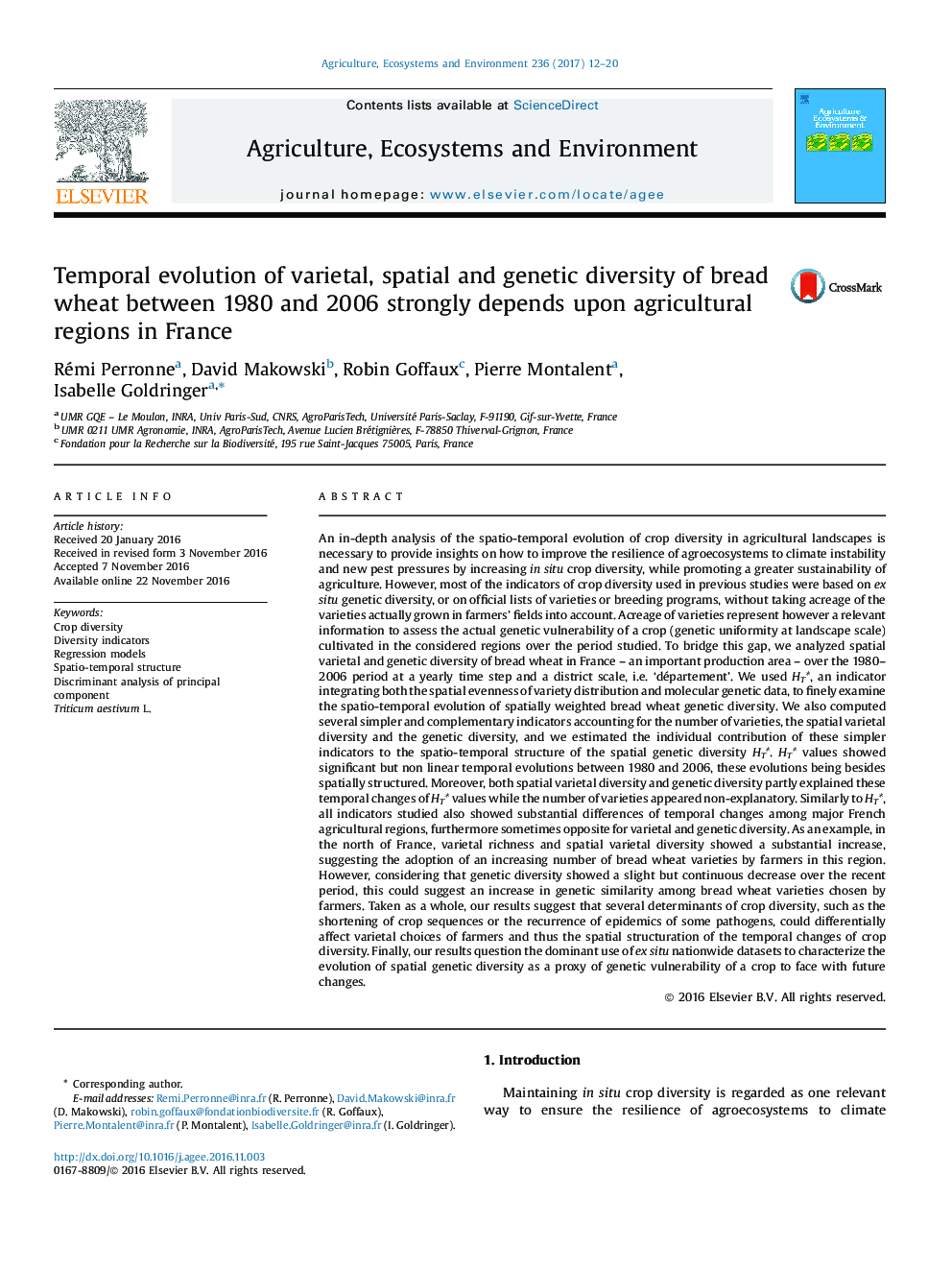| کد مقاله | کد نشریه | سال انتشار | مقاله انگلیسی | نسخه تمام متن |
|---|---|---|---|---|
| 5537871 | 1552016 | 2017 | 9 صفحه PDF | دانلود رایگان |
عنوان انگلیسی مقاله ISI
Temporal evolution of varietal, spatial and genetic diversity of bread wheat between 1980 and 2006 strongly depends upon agricultural regions in France
ترجمه فارسی عنوان
تکامل موقتی تنوع گونه ای، فضایی و ژنتیکی گندم نان بین سال های 1980 تا 2006 به شدت به مناطق کشاورزی فرانسه بستگی دارد
دانلود مقاله + سفارش ترجمه
دانلود مقاله ISI انگلیسی
رایگان برای ایرانیان
موضوعات مرتبط
علوم زیستی و بیوفناوری
علوم کشاورزی و بیولوژیک
علوم زراعت و اصلاح نباتات
چکیده انگلیسی
An in-depth analysis of the spatio-temporal evolution of crop diversity in agricultural landscapes is necessary to provide insights on how to improve the resilience of agroecosystems to climate instability and new pest pressures by increasing in situ crop diversity, while promoting a greater sustainability of agriculture. However, most of the indicators of crop diversity used in previous studies were based on ex situ genetic diversity, or on official lists of varieties or breeding programs, without taking acreage of the varieties actually grown in farmers' fields into account. Acreage of varieties represent however a relevant information to assess the actual genetic vulnerability of a crop (genetic uniformity at landscape scale) cultivated in the considered regions over the period studied. To bridge this gap, we analyzed spatial varietal and genetic diversity of bread wheat in France - an important production area - over the 1980-2006 period at a yearly time step and a district scale, i.e. 'département'. We used HT*, an indicator integrating both the spatial evenness of variety distribution and molecular genetic data, to finely examine the spatio-temporal evolution of spatially weighted bread wheat genetic diversity. We also computed several simpler and complementary indicators accounting for the number of varieties, the spatial varietal diversity and the genetic diversity, and we estimated the individual contribution of these simpler indicators to the spatio-temporal structure of the spatial genetic diversity HT*. HT* values showed significant but non linear temporal evolutions between 1980 and 2006, these evolutions being besides spatially structured. Moreover, both spatial varietal diversity and genetic diversity partly explained these temporal changes of HT* values while the number of varieties appeared non-explanatory. Similarly to HT*, all indicators studied also showed substantial differences of temporal changes among major French agricultural regions, furthermore sometimes opposite for varietal and genetic diversity. As an example, in the north of France, varietal richness and spatial varietal diversity showed a substantial increase, suggesting the adoption of an increasing number of bread wheat varieties by farmers in this region. However, considering that genetic diversity showed a slight but continuous decrease over the recent period, this could suggest an increase in genetic similarity among bread wheat varieties chosen by farmers. Taken as a whole, our results suggest that several determinants of crop diversity, such as the shortening of crop sequences or the recurrence of epidemics of some pathogens, could differentially affect varietal choices of farmers and thus the spatial structuration of the temporal changes of crop diversity. Finally, our results question the dominant use of ex situ nationwide datasets to characterize the evolution of spatial genetic diversity as a proxy of genetic vulnerability of a crop to face with future changes.
ناشر
Database: Elsevier - ScienceDirect (ساینس دایرکت)
Journal: Agriculture, Ecosystems & Environment - Volume 236, 2 January 2017, Pages 12-20
Journal: Agriculture, Ecosystems & Environment - Volume 236, 2 January 2017, Pages 12-20
نویسندگان
Rémi Perronne, David Makowski, Robin Goffaux, Pierre Montalent, Isabelle Goldringer,
